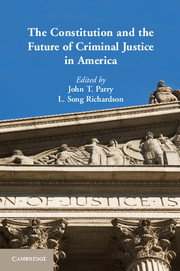Book contents
- Frontmatter
- Contents
- Contributors
- Acknowledgments
- Introduction
- Part I Foundations – The Scope of Criminal Law and Access to Counsel
- Part II Race and Criminal Procedure
- 3 The Challenges of “Quality of Life” Policing for the Fourth Amendment
- 4 Implicit Racial Bias and the Fourth Amendment
- Part III Policing and Privacy
- Part IV Technology and the Surveillance Society
- Part V Confessions and miranda
- Part VI Conviction, Sentencing, and Incarceration
- Part VII Emergencies and Borders – Immigration, Terrorism, National Security, and Transnational Crime
- Index
- References
4 - Implicit Racial Bias and the Fourth Amendment
Published online by Cambridge University Press: 05 June 2014
- Frontmatter
- Contents
- Contributors
- Acknowledgments
- Introduction
- Part I Foundations – The Scope of Criminal Law and Access to Counsel
- Part II Race and Criminal Procedure
- 3 The Challenges of “Quality of Life” Policing for the Fourth Amendment
- 4 Implicit Racial Bias and the Fourth Amendment
- Part III Policing and Privacy
- Part IV Technology and the Surveillance Society
- Part V Confessions and miranda
- Part VI Conviction, Sentencing, and Incarceration
- Part VII Emergencies and Borders – Immigration, Terrorism, National Security, and Transnational Crime
- Index
- References
Summary
Introduction
In recent years, legal scholars have utilized the science of implicit social cognition to reveal how unconscious biases affect perceptions, behaviors, and judgments. This science combines the lessons of social psychology, cognitive psychology, and cognitive neuroscience to examine mental processes that occur outside conscious awareness and that operate without conscious control. Employing this science, scholars have critiqued legal doctrine and challenged courts to take accurate theories of human behavior into account or to explain their failure to do so.
The lessons of implicit social cognition can contribute much to the understanding of police behavior, especially as it relates to hit rates or “arrest efficiency” – the rates at which police find evidence of criminal activity when they conduct a stop and frisk. Empirical evidence consistently demonstrates that the police disproportionately stop and frisk nonwhites, although stops and searches of whites are often more successful in yielding evidence of criminal activity. While economists and criminal process scholars both suggest that arrest inefficiency is due to conscious racial bias, the science reveals that unconscious biases may also contribute. Taking account of the science of implicit social cognition is important to the study of Fourth Amendment jurisprudence and policing. The failure to recognize the effects of implicit bias has resulted in a Fourth Amendment jurisprudence that unintentionally exacerbates the effects of implicit bias on police behavior. Changes to Fourth Amendment doctrine as well as structural changes within police departments are necessary steps to protect privacy against arbitrary government intrusion more effectively.
- Type
- Chapter
- Information
- Publisher: Cambridge University PressPrint publication year: 2013
References
- 1
- Cited by



